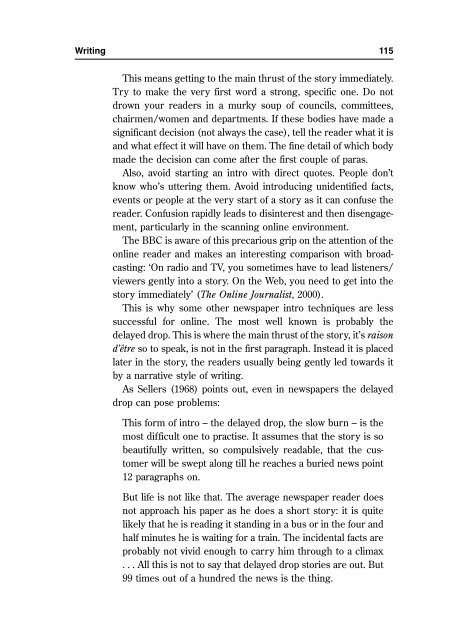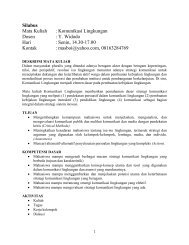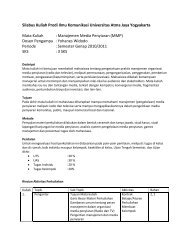1What is online journalism? - Ayo Menulis FISIP UAJY
1What is online journalism? - Ayo Menulis FISIP UAJY
1What is online journalism? - Ayo Menulis FISIP UAJY
You also want an ePaper? Increase the reach of your titles
YUMPU automatically turns print PDFs into web optimized ePapers that Google loves.
Writing 115<br />
Th<strong>is</strong> means getting to the main thrust of the story immediately.<br />
Try to make the very first word a strong, specific one. Do not<br />
drown your readers in a murky soup of councils, committees,<br />
chairmen/women and departments. If these bodies have made a<br />
significant dec<strong>is</strong>ion (not always the case), tell the reader what it <strong>is</strong><br />
and what effect it will have on them. The fine detail of which body<br />
made the dec<strong>is</strong>ion can come after the first couple of paras.<br />
Also, avoid starting an intro with direct quotes. People don’t<br />
know who’s uttering them. Avoid introducing unidentified facts,<br />
events or people at the very start of a story as it can confuse the<br />
reader. Confusion rapidly leads to d<strong>is</strong>interest and then d<strong>is</strong>engagement,<br />
particularly in the scanning <strong>online</strong> environment.<br />
The BBC <strong>is</strong> aware of th<strong>is</strong> precarious grip on the attention of the<br />
<strong>online</strong> reader and makes an interesting compar<strong>is</strong>on with broadcasting:<br />
‘On radio and TV, you sometimes have to lead l<strong>is</strong>teners/<br />
viewers gently into a story. On the Web, you need to get into the<br />
story immediately’ (The Online Journal<strong>is</strong>t, 2000).<br />
Th<strong>is</strong> <strong>is</strong> why some other newspaper intro techniques are less<br />
successful for <strong>online</strong>. The most well known <strong>is</strong> probably the<br />
delayed drop. Th<strong>is</strong> <strong>is</strong> where the main thrust of the story, it’s ra<strong>is</strong>on<br />
d’être so to speak, <strong>is</strong> not in the first paragraph. Instead it <strong>is</strong> placed<br />
later in the story, the readers usually being gently led towards it<br />
by a narrative style of writing.<br />
As Sellers (1968) points out, even in newspapers the delayed<br />
drop can pose problems:<br />
Th<strong>is</strong> form of intro – the delayed drop, the slow burn – <strong>is</strong> the<br />
most difficult one to pract<strong>is</strong>e. It assumes that the story <strong>is</strong> so<br />
beautifully written, so compulsively readable, that the customer<br />
will be swept along till he reaches a buried news point<br />
12 paragraphs on.<br />
But life <strong>is</strong> not like that. The average newspaper reader does<br />
not approach h<strong>is</strong> paper as he does a short story: it <strong>is</strong> quite<br />
likely that he <strong>is</strong> reading it standing in a bus or in the four and<br />
half minutes he <strong>is</strong> waiting for a train. The incidental facts are<br />
probably not vivid enough to carry him through to a climax<br />
. . . All th<strong>is</strong> <strong>is</strong> not to say that delayed drop stories are out. But<br />
99 times out of a hundred the news <strong>is</strong> the thing.


